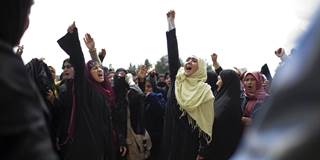Many diplomats privately concede that women’s rights are not a high priority in peace talks with the Taliban. But a peace agreement without some guarantees for half the Afghan population is not worth having, and a deal that is not partly negotiated by women is much less likely to hold.
WASHINGTON, DC – When Zalmay Khalilzad was appointed as the US Special Representative for Afghanistan Reconciliation in September 2018, an end to America’s longest war seemed finally to be in sight. Now, following President Donald Trump’s sudden announcement in late December that the United States will withdraw 7,000 of its troops from the country, the pressure on Khalilzad to secure a deal with the Taliban by spring has increased dramatically. Many now fear that Trump wants to leave Afghanistan regardless of the consequences, least of all for the country’s women.
Afghan women’s progress is essential to that of Afghanistan as a whole. Yet women are suddenly as invisible in international press coverage as they are in much of Afghan society. Privately, many diplomats concede that women’s rights are simply not a high priority in talks with the Taliban: nice but not necessary, and, given the Taliban’s horrific treatment of women when they ruled the country in the 1990s, probably a non-starter anyway.
This line of thinking is wrong. The Taliban leadership know that they have a potentially disastrous image problem. The international community ostracized their government in the 1990s, owing in part to their treatment of women. To be accepted as a legitimate political movement and a viable partner in any future power-sharing deal, Taliban leaders believe they must demonstrate that they have changed their views.

WASHINGTON, DC – When Zalmay Khalilzad was appointed as the US Special Representative for Afghanistan Reconciliation in September 2018, an end to America’s longest war seemed finally to be in sight. Now, following President Donald Trump’s sudden announcement in late December that the United States will withdraw 7,000 of its troops from the country, the pressure on Khalilzad to secure a deal with the Taliban by spring has increased dramatically. Many now fear that Trump wants to leave Afghanistan regardless of the consequences, least of all for the country’s women.
Afghan women’s progress is essential to that of Afghanistan as a whole. Yet women are suddenly as invisible in international press coverage as they are in much of Afghan society. Privately, many diplomats concede that women’s rights are simply not a high priority in talks with the Taliban: nice but not necessary, and, given the Taliban’s horrific treatment of women when they ruled the country in the 1990s, probably a non-starter anyway.
This line of thinking is wrong. The Taliban leadership know that they have a potentially disastrous image problem. The international community ostracized their government in the 1990s, owing in part to their treatment of women. To be accepted as a legitimate political movement and a viable partner in any future power-sharing deal, Taliban leaders believe they must demonstrate that they have changed their views.